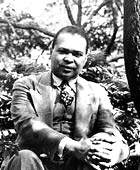Born in 1903 in New York City, Countee Cullen was raised in a Methodist parsonage. He attended De Witt Clinton High School in New York and began writing poetry at the age of fourteen.
In 1922, Cullen entered New York University. His poems were published in The Crisis, under the leadership of W. E. B. Du Bois, and Opportunity, a magazine of the National Urban League. He was soon after published in Harper's, the Century Magazine, and Poetry. He won several awards for his poem, "Ballad of the Brown Girl," and graduated from New York University in 1923. That same year, Harper published his first volume of verse, Color, and he was admitted to Harvard University where he completed a master's degree.
His second volume of poetry, Copper Sun (1927), met with controversy in the black community because Cullen did not give the subject of race the same attention he had given it in Color.
He was raised and educated in a primarily white community, and he differed from other poets of the Harlem Renaissance like 'Langston Hughes' in that he lacked the background to comment from personal experience on the lives of other blacks or use popular black themes in his writing.
An imaginative lyric poet, he wrote in the tradition of Keats and Shelley and was resistant to the new poetic techniques of the Modernists. He died in 1946. |






